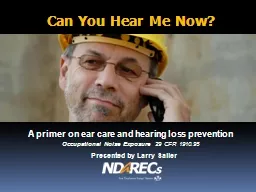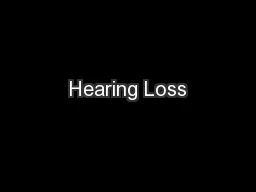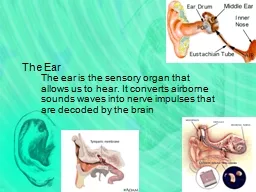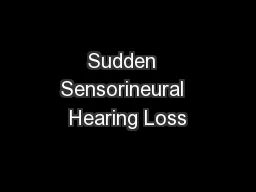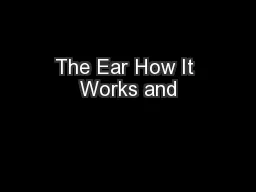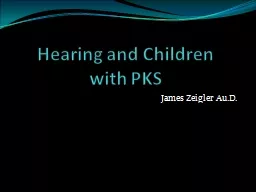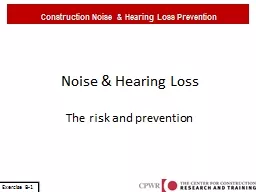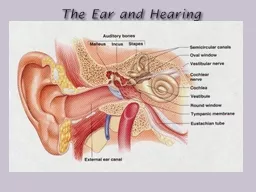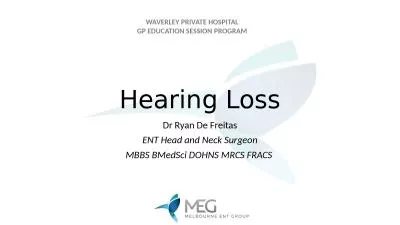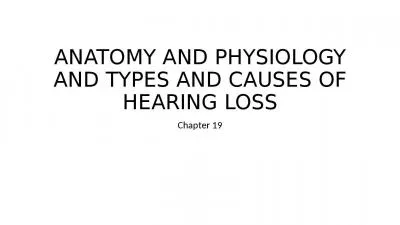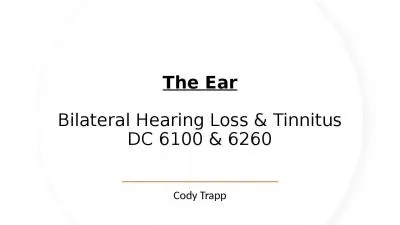PPT-A primer on ear care and hearing loss prevention
Author : marina-yarberry | Published Date : 2017-12-09
Occupational Noise Exposure 29 CFR 191095 Presented by Larry Sailer Can You Hear Me Now HEARING SAFETY Purpose In todays program youll learn about your auditory
Presentation Embed Code
Download Presentation
Download Presentation The PPT/PDF document "A primer on ear care and hearing loss pr..." is the property of its rightful owner. Permission is granted to download and print the materials on this website for personal, non-commercial use only, and to display it on your personal computer provided you do not modify the materials and that you retain all copyright notices contained in the materials. By downloading content from our website, you accept the terms of this agreement.
A primer on ear care and hearing loss prevention: Transcript
Occupational Noise Exposure 29 CFR 191095 Presented by Larry Sailer Can You Hear Me Now HEARING SAFETY Purpose In todays program youll learn about your auditory system and how important it is to preserve your hearing through good safety practices. What is the function of the ear?. Are there different parts? If so, can you name them?. How does the ear work? . What is that . sound. ?. A Story About the Ear . Mrs. . Mackens. Anatomy of the Ear. Dr. Ryan De Freitas. ENT Head and Neck Surgeon. MBBS . BMedSci. . DOHNS . MRCS FRACS . WAVERLEY PRIVATE HOSPITAL. GP EDUCATION SESSION PROGRAM. About Me. Subspecialty Interests. Head and Neck. Thyroid. The ear is the sensory organ that allows us to hear. It converts airborne sounds waves into nerve impulses that are decoded by the brain. Parts of the ear. 1) Outer ear (external). Auricle or . pinna. Dr. Dinesh Kumar Sharma. Assistant Professor, Department of ENT, GMC Amritsar. Overview. . Introduction. Definition. According to National Institute on Deafness and other communication disorder (NIDCD) criteria defined as:. Things That Can Go Wrong. Function of the Ear. The ear serves two functions: hearing and balance.. The organs for these functions are the cochlea for hearing and the semicircular canals for balance.. James Zeigler . Au.D. .. Thank You . Protocol for screening and evaluating hearing loss in infants and young children. Conductive and . sensorineural. hearing losses. Amount of hearing loss. Audiogram overview. Noise & Hearing Loss The risk and prevention Construction Noise & Hearing Loss Prevention Exercise B-1 Noise – What are the risks? The Cost of Hearing Loss How loud is too loud? NIOSH Sound Level Meter app for iPhones Outer Ear- . main purpose is to funnel sound waves to inner ear.. 1a. . Auricle. -gathers sound waves . 1b. . External acoustic meatus- . transmits sound waves to tympanic membrane. 1c. . Tympanic membrane . Conductive hearing lossA conductive hearing loss is causedby any condition or disease that impedes the conveyance of sound in its mechanical form through the middle ear cavity to the inner ear. A cond As your child participates in hearing testing, you will hear hearing loss described in different ways. This section explains all about hearing loss. TYPE OF HEARING LOSS How Do We Hear? The Ear is m Experience a hearing revolution with \'Revolutionizing Hearing Care: The Innovative Technology of Oticon Hearing Aids.\' Discover unrivaled sound clarity and personalized experiences, as Oticon transforms hearing solutions. Explore groundbreaking technology that connects, performs, and empowers. Embrace the future of hearing care where innovation meets comfort and communication knows no bounds. Join the movement: ENT Head and Neck Surgeon. MBBS . BMedSci. . DOHNS . MRCS FRACS . WAVERLEY PRIVATE HOSPITAL. GP EDUCATION SESSION PROGRAM. About Me. Subspecialty Interests. Head and Neck. Thyroid. Background. Hobart. Chapter 19. Outline. I. Anatomy and Physiology of the Hearing Mechanism. II. General Facts About Hearing Loss. III. Conductive Hearing Loss. IV. Auditory Nervous System Impairments. V. Hearing Loss and Disorders of the Inner Ear. DC 6100 & 6260. Cody Trapp. Determine hearing loss in service: . Check the MOS list for the veteran’s noise exposure. If not on the list provide a statement of noise exposure. Check STRs for significant “threshold shift” in service - which VA does not outright define.
Download Document
Here is the link to download the presentation.
"A primer on ear care and hearing loss prevention"The content belongs to its owner. You may download and print it for personal use, without modification, and keep all copyright notices. By downloading, you agree to these terms.
Related Documents

